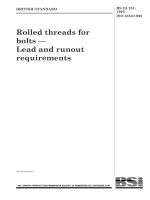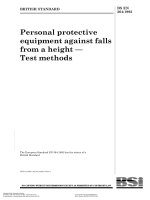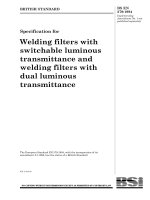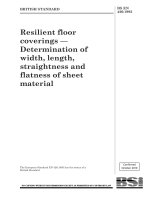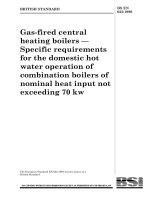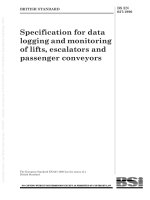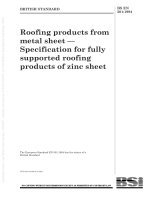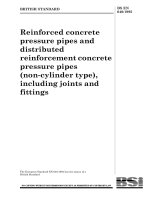Bsi bs en 00377 1993 (1999)
Bạn đang xem bản rút gọn của tài liệu. Xem và tải ngay bản đầy đủ của tài liệu tại đây (545.76 KB, 16 trang )
BRITISH STANDARD
BS EN
377:1993
Incorporating
Amendment No. 1
Lubricants for
applications in
appliances and
associated controls
using combustible
gases except those
designed for use in
industrial processes
The European Standard EN 377:1993, with the incorporation of its amendment
A1:1996, has the status of a British Standard
BS EN 377:1993
Cooperating organizations
The European Committee for Standardization (CEN), under whose supervision
this European Standard was prepared, comprises the national standards
organizations of the following countries:
Austria
Belgium
Denmark
Finland
France
Germany
Greece
Iceland
Ireland
Italy
Luxembourg
Netherlands
Norway
Portugal
Spain
Sweden
Switzerland
United Kingdom
This British Standard, having
been prepared under the
direction of the Gas
Standards Policy
Committee, was published
under the authority of the
Standards Board and
comes into effect on
15 August 1993
© BSI 12-1999
The following BSI references
relate to the work on this
standard:
Committee reference GSE/22
Draft for comment 90/78081 DC
ISBN 0 580 21251 3
Oesterreichisches Normungsinstitut
Institut belge de normalisation
Dansk Standardiseringsraad
Suomen Standardisoimisliito, r.y.
Association franỗaise de normalisation
Deutsches Institut fỹr Normung e.V.
Hellenic Organization for Standardization
Technological Institute of Iceland
National Standards Authority of Ireland
Ente Nazionale Italiano di Unificazione
Inspection du Travail et des Mines
Nederlands Normalisatie-instituut
Norges Standardiseringsforbund
Instituto Portugs da Qualidade
Asociación Espola de Normalización y Certificación
Standardiseringskommissionen i Sverige
Association suisse de normalisation
British Standards Institution
Amendments issued since publication
Amd. No.
Date
Comments
9328
December
1996
Indicated by a sideline in the margin
BS EN 377:1993
Contents
Cooperating organizations
National foreword
Foreword
Text of EN 377
National annex NA (informative) Committees responsible
National annex NB (informative) Cross-references
© BSI 12-1999
Page
Inside front cover
ii
2
3
Inside back cover
Inside back cover
i
BS EN 377:1993
National foreword
This British Standard has been prepared under the direction of the Gas
Standards Policy Committee and is the English language version of EN 377:1993
Lubricants for applications in appliances and associated controls using
combustible gases except those designed for use in industrial processes, including
amendment 1, published by the European Committee for Standardization (CEN).
EN 377 was produced as a result of international discussions in which the
United Kingdom took an active part.
A British Standard does not purport to include all the necessary provisions of a
contract. Users of British Standards are responsible for their correct application.
Compliance with a British Standard does not of itself confer immunity
from legal obligations.
Summary of pages
This document comprises a front cover, an inside front cover, pages i and ii,
the EN title page, pages 2 to 10, an inside back cover and a back cover.
This standard has been updated (see copyright date) and may have had
amendments incorporated. This will be indicated in the amendment table on the
inside front cover.
ii
© BSI 12-1999
EUROPEAN STANDARD
EN 377
NORME EUROPÉENNE
May 1993
+ A1
EUROPÄISCHE NORM
March 1996
UDC 621.892:641.534:644.62:683.97:622.95:697.245:620.1
Descriptors: Household appliances, gas appliances, lubricants, classifications, specifications, physicochemical properties, tests
English version
Lubricants for applications in appliances and associated
controls using combustible gases except those designed for
use in industrial processes
(includes amendment A1:1006)
Lubrifiants destinés aux appareils et
équipement associés utilisant les combustibles
gazeux à l’exception des appareils
spécifiquement destinés à un usage industriel
(inclut l’amendement A1:1996)
Schmierstoffe für die Anwendung in Geräten
und zugehưrigen Stell-Geräten für Brenngase
aer denjenigen die für die Anwendung in
industriellen Prozessen vorgesehen sind
(enthält Änderung A1:1996)
This European Standard was approved by CEN on 1993-04-25. CEN members
are bound to comply with the CEN/CENELEC Internal Regulations which
stipulate the conditions for giving this European Standard the status of a
national standard without any alteration.
Up-to-date lists and bibliographical references concerning such national
standards may be obtained on application to the Central Secretariat or to any
CEN member.
This European Standard exists in three official versions (English, French,
German). A version in any other language made by translation under the
responsibility of a CEN member into its own language and notified to the
Central Secretariat has the same status as the official versions.
CEN members are the national standard bodies of Austria, Belgium, Denmark,
Finland, France, Germany, Greece, Iceland, Ireland, Italy, Luxembourg,
Netherlands, Norway, Portugal, Spain, Sweden, Switzerland and
United Kingdom.
CEN
European Committee for Standardization
Comité Européen de Normalisation
Europäisches Komitee für Normung
Central Secretariat: rue de Stassart 36, B-1050 Brussels
© CEN 1993 Copyright reserved to CEN members
Ref. No. EN 377:1993 + A1:1996 E
EN 377:1993
Foreword
Contents
This European Standard has been prepared by
Technical Committee CEN/TC 108 “Sealing
materials and lubricants for gas appliances and gas
equipment”.
This European Standard has been prepared under a
mandate given to CEN by the Commission of the
European Communities and the European Free
Trade Association, and supports essential
requirements of EC Directive(s).
This European Standard shall be given the status of
a national standard, either by publication of an
identical text or by endorsement, at the latest by
November 1993, and conflicting national standards
shall be withdrawn at the latest by November 1993.
In accordance with the CEN/CENELEC Internal
Regulations, the following countries are bound to
implement this European Standard: Austria,
Belgium, Denmark, Finland, France, Germany,
Greece, Iceland, Ireland, Italy, Luxembourg,
Netherlands, Norway, Portugal, Spain, Sweden,
Switzerland and United Kingdom.
Page
Foreword
2
Introduction
3
1
Scope
3
2
Normative references
3
3
Classification of the lubricants
3
4
Requirements
3
5
Methods of test
3
Annex A (informative) Production of the
standard reference elastomer
9
Figure 1 — Overall view of the assembly
5
Figure 2 — Casing
6
Figure 3 — Nozzle
6
Figure 4 — Nozzle holder
6
Figure 5 — Control gauge
6
Figure 6 — Weighing glass
7
Figure 7 — U shape tubes with ground stopcocks 8
Figure 8 — Fixing of spring steel guard
8
Table 1 — Temperature classes
3
Table 2
7
Table 3
7
Table 4
8
Table A.1 — Compositions of SRE-NBR 1
(in part of mass)
9
Table A.2 — Instructions for making the
mixture
9
Table A.3 — Laboratory rolling machine
10
Table A.4 — Requirements and testing
10
Foreword to Amendment A1
This Amendment EN 377:1993/A1:1996 to
EN 377:1993 has been prepared by Technical
Committee CEN/TC 108, Sealing materials and
lubricants for gas appliances and gas equipment,
the secretariat of which is held by NNI.
This Amendment to the European Standard
EN 377:1993 shall be given the status of a national
standard, either by publication of an identical text
or by endorsement, at the latest by January 1997,
and conflicting national standards shall be
withdrawn at the latest by January 1997.
According to the CEN/CENELEC Internal
Regulations, the national standards organizations
of the following countries are bound to implement
this Amendment: Austria, Belgium, Denmark,
Finland, France, Germany, Greece, Iceland,
Ireland, Italy, Luxembourg, Netherlands, Norway,
Portugal, Spain, Sweden, Switzerland and the
United Kingdom.
Lubricants for applications in appliances and
associated controls using combustible gases except
those designed for use in industrial processes.
Amendment No. 1 is issued after evaluation of one
year of test experience.
2
© BSI 12-1999
EN 377:1993
Introduction
This standard specifies the essential physical and
chemical characteristics of lubricants to be used in
gas and associated controls appliances using
combustible gases except those designed for use in
industrial processes.
Judgement on the suitability of the use of these
lubricants for any given equipment is not the object
of the present standard. This has to be verified by
functional tests laid down in the appropriate
appliance or control standards.
Notwithstanding the limits of operating
temperature covered by this standard, it may be
necessary to check any specific operating
temperature by functional testing and compatibility
trials.
The lubricants covered by this standard are
compatible with copper and copper alloys.
Compatibility with other metals — e.g. aluminium
and aluminium alloys (which might be corroded by
alkaline soaps) — has to be confirmed by long term
functional tests at the maximum working
temperature.
This standard contains an informative Annex A on
the preparation of a standard reference elastomer
used for testing the compatibility with elastomers.
1 Scope
This standard specifies requirements and methods
of test for lubricants to be used in gas appliances of
all categories including auxiliary equipment
mounted or intended to be mounted on such
appliances and which may be in contact with
combustible gases, except those designed for use in
industrial processes.
2 Normative references
This European Standard incorporates by dated or
undated reference, provisions from other
publications. These normative references are cited
at the appropriate places in the text and the
publications are listed hereafter. For dated
references, subsequent amendments to or revisions
of any of these publications apply to this European
Standard. For undated references the latest edition
of the publication referred to applies.
ISO 1817:1985, Rubber, vulcanized —
Determination of the effect of liquids.
ISO 2160:1985, Petroleum products —
Corrosiveness to copper — Copper strip test.
ISO 3219:1977, Plastics — Polymers in the liquid,
emulsified or dispersed state — Determination of
viscosity with a rotational viscometer working at
defined shear rate.
© BSI 12-1999
ISO 6743-9:1987, Lubricants, industrial oils and
related products (class L) — Classification —
Part 9: Family X (Greases).
3 Classification of the lubricants
The manufacturer shall declare the temperature
class of the lubricant as given in Table 1.
4 Requirements
4.1 Behaviour at low temperature
The flow pressure of the lubricant, determined
according to 5.1, shall not exceed 1 500 mbar.
4.2 Behaviour at high temperature
The loss in mass of the lubricant, tested according
to 5.2, shall not exceed 8 % of the initial value.
Table 1 — Temperature classes
Range of operating
temperature (°C)
From
to
Class
0
60
0
90
0
0
0
120 140 160
A
B
C
D
E
In addition, the apparent dynamic viscosity of the
lubricant shall not be increased by more than 100 %
or decreased by more than 50 % compared with the
initial value.
4.3 Resistance to gas
The increase in mass of the lubricant in gaseous
butane, tested according to 5.3, shall not
exceed 10 % of the initial value.
4.4 Compatibility with copper
The appearance of copper test strips tested in
accordance with 5.4 shall give a classification 2 or
less for all classes in accordance with clause 5 of
ISO 2160:1985 when compared with the reference
strips.
4.5 Compatibility with elastomers
The increase in volume of the standard reference
nitrile elastomer, tested in lubricant according
to 5.5, shall not exceed 10 % of the initial value.
The maximum change in hardness is 10 IRHD.
5 Methods of test
5.1 Behaviour at low temperature
5.1.1 Principle
The method consists of determining the relative
flow pressure of the lubricant at 0 °C, that is to say,
the pressure required for complete expulsion of the
lubricant contained in a nozzle.
3
EN 377:1993
5.1.2 Apparatus (Figure 1)
The apparatus comprises a tube in the shape of a
cross made from glass or metal, with a nozzle and its
holder at the end of the lower tube section and a
stopper with a hole for the thermometer at the top
end of the upper tube section complete with holder.
One of the lateral tube sections is connected to an
air supply under pressure, the other to a pressure
gauge.
These different components are described below.
— Nozzle
The nozzle (Figure 3) is a steel cylinder having a
collar and with an orifice in the form of a
truncated cone. It is mounted in a nozzle holder
(Figure 4) which, in turn, screws onto a brass
casing (Figure 2) retained with a suitable glue.
— Thermometer
The thermometer measures the test temperature
with an accuracy of ± 1 °C. It is inserted into the
vertical section of the test apparatus where it is
held in position by a rubber stopper through
which it passes and which fits into the enlarged
section of the tube thus locating the
thermometer in the centre of the triangular
orifice at the entry to the nozzle in conjunction
with the casing.
— Control gauge
This accessory (Figure 5) is used to position the
lower part of the thermometer in the casing.
— Pressure gauge up to 1 500 mbar — having
readability u 5 mbar.
— Test tube with a diameter of around 25 mm
and a height of 130 mm to accept the lower part
of the equipment with the nozzle. It is closed by a
perforated and split rubber stopper.
— Liquid bath with cover, containing a liquid, the
temperature of which can be controlled
to (0 ± 1) °C.
The bath cover shall have an opening through
which the lower part of the test apparatus (N.B.
Inserted into the test tube) can be immersed into
the temperature controlled liquid to a depth of at
least 65 mm.
— Chronometer, tolerance ± 1 s.
— Cotton lint or absorbent paper
— Glass plate
— Source of compressed air
5.1.3 Method of operation
Clean the base of the apparatus and the nozzle
carefully with cotton lint or absorbent paper
without using solvents.
4
The thermometer is mounted as shown in Figure 1
and adjusted by means of the control gauge which is
inserted into the apparatus through the nozzle for a
length of 21 mm. The lower step of the gauge is
positioned level with the exit of the nozzle. The
lower end of the thermometer shall touch the upper
end of the gauge.
Remove the nozzle.
Fill the nozzle by spreading lubricant on the glass
plate as a bubble free layer and placing the nozzle on
this bed of lubricant with the large opening
underneath, pressing until it contacts the glass
plate.The nozzle should then be separated from the
glass plate by lateral movement and the operation
repeated until lubricant is emitted from the smaller
opening. Excess lubricant is removed with a
spatula.
Assemble the apparatus with the nozzle arranged as
in Figure 1 and insert the lower part into the test
tube. Connect one of the laterals to the pressure
source and the other to the pressure gauge.
Condition the apparatus at a temperature
of (0 ± 1) °C for (2,5 ± 0,5) h in the liquid bath.
Raise the pressure by stages of 25 mbar every 30 s.
The flow pressure is defined as being the highest
level of pressure reached, corresponding to the
complete expulsion of the lubricant from the nozzle.
5.2 Behaviour at high temperatures
Three weighing devices consisting of two ground
glass discs of 60 mm diameter (Figure 6) are cleaned
with acetone and weighed. (1 ± 0,05) g of the
lubricant is equally distributed on both parts of the
devices by circling movements. Then both discs are
separated by lateral movement to give a smooth
lubrication film. The lubricant samples are weighed
to 1 mg and placed for (24
0 )
–0,5
h in a normal oven
at temperatures as shown in Table 2.
The change in mass with reference to the initial
mass of the samples is determined after the devices
have cooled down to ambient temperature in a
desiccator containing calcium chloride. Use the
arithmetic mean value of the three results obtained.
The change of the viscosity is determined on
lubricant samples which were stored in the same
manner at temperatures shown in Table 3.
The test method is that of cone and plate described
in ISO 3219 with the following parameters:
— Temperature (23 ± 0,2) °C;
— Shear rate 250 s–1.
© BSI 12-1999
EN 377:1993
Figure 1 — Overall view of the assembly
© BSI 12-1999
5
EN 377:1993
Figure 4 — Nozzle holder
Figure 2 — Casing
Figure 5 — Control gauge
The values are read off after a rotation period of 30 s
and compared with the initial value. Use the
arithmetic mean value of the three results obtained.
5.3 Resistance to gas
Figure 3 — Nozzle
6
The mass increase of the lubricant in gaseous
butane (W 99,5 % n-butane by mass) is determined
in a U-tube with ground stopcocks, see Figure 7.
Each side of the U-tube contains an aluminium
strip 110 m × 10 mm × 0,5 mm. The stopcocks are
greased with the lubricant to be tested in such a way
that no lubricant comes out from the ground glass.
The stopcocks should be protected against over
pressure inside the U-tube by means of a guard or a
steel spring (e.g. Figure 8).
© BSI 12-1999
EN 377:1993
Figure 6 — Weighing glass
Table 2
Temperature (°C)
Class
A
B
C
D
E
90 ± 1
120 ± 2
150 ± 2
170 ± 2
190 ± 2
Table 3
Class
A
B
C
D
E
© BSI 12-1999
Temperature (°C)
60 ± 1
90 ± 1
120 ± 1
140 ± 2
160 ± 2
The mass (m1) of the U-tube prepared in this way is
determined to 1 mg. Afterwards the U-tube is
flushed free of air in a thermostatically controlled
water bath at (20 ± 1) °C for 10 min with butane
(about 150 ml/min). Thereafter the outlet stopcock
is closed and the pressure is adjusted to the absolute
test pressure of (1 065 ± 5) mbar. After temperature
equalization (about 2 min) the inlet stopcock is
closed and the mass (m2) of the carefully dried
U-tube is determined.
The U-tube is opened and flushed with air. A total
mass of (2,0 ± 0,1) g of lubricant is equally spread
on both sides of the aluminium strips
leaving 10 mm at the end free of lubricant for
handling by forceps. The exact amount of lubricant
is the difference between the mass of the U-tube
with the coated aluminium strips (m3) and
the mass m1.
After flushing the U-tube free of air in the
prescribed manner let butane under an absolute
pressure of (1 065 ± 5) mbar at (20 ± 1) °C act on
the lubricant sample for 1 h and determine
thereafter the mass of the U-tube (m4) under test
pressure analogous to m2.
Such 1 h loading tests with subsequent weighing
are repeated until the mass (m4) differs by not more
than 2 mg from the previous measured value. Note
that care should be taken that the gas lines are first
flushed free of air and adjusted to the prescribed
test pressure, before opening the inlet stopcock of
the U-tube again.
The absorption (B) by the lubricant of butane is
calculated as mass % from the maximum value of
mass m4 according to the following equation:
( m 4 – m2 ) – ( m3 – m1 )
B = ------------------------------------------------------------ ´ 100
( m3 – m 1 )
5.4 Compatibility with copper
The test is carried out in accordance with ISO 2160
using the method described for lubricants (8.1.6)
with the special condition, shown in Table 4. The
0 ) h.
test period is (24 –0,5
5.5 Compatibility with elastomers
The compatibility of lubricants with standard
reference elastomer according to Annex A is tested
in accordance with ISO 1817 — volumetric
method (8.2) and hardness test (11.2) — and the
following special conditions.
Three test pieces of 50 mm × 20 mm × 2 mm were
weighed and immersed into at least 50 ml of
lubricant for (168 –20 ) h at a temperature
of (100 ± 1) °C.
Determine the increase in volume and the change in
hardness.
7
EN 377:1993
Figure 7 — U shape tubes with ground stopcocks
Table 4
Class
A
B
C
D
E
Test temperature (°C)
60 ± 1
90 ± 1
120 ± 2
140 ± 2
160 ± 2
Figure 8 — Fixing of spring steel guard
8
© BSI 12-1999
EN 377:1993
Annex A (informative)
Production of the standard reference
elastomer
A.1 Composition
The standard reference elastomer (SRE) for testing
the compatibility with lubricants consists of a
butadien acrylonitrile rubber (NBR) which is
cross-linked by peroxide. Table A.1 shows its
composition.
The parts of the composition are mixed together at a
roller surface temperature of (50 ± 5) °C preferably
using the information of Table A.2.
Table A.1 — Composition of SRE-NBR 1 (in
parts of mass)
This information refers to a laboratory rolling
machine with the properties shown in Table A.3 and
a standard mixture of 400 g rubber.
NOTE Sheets of standard reference elastomer with the
designation SRE-NBR 1 are available from Bundesanstalt für
Materialforschung und prüfung (BAM), unter den Eichen 87,
D-1000 Berlin 45.
The produced mixture is stored for at least 2 h and
not more than 24 h at the temperature of 23 °C.
From the stored mixture a plate which nearly fits
the hole of the mould is cut, on a clean dry base
(preferably a metal plate).
A.2 Vulcanizing
Before the filling of the form [size:
length ë 150 mm, width ë 150 mm,
height ë (2,0 ± 0,2) mm], the form is preheated for
at least 20 min at a temperature of (170 ± 2) °C in a
NBR with (28 ± 0,5) weight %
press with a locking pressure of at
acrylonitrile
100,0
least 35 bar (3,5 MN/m2).
N-(1,3 Dimethyl-butyl)-N-phenyl-pA suitably cut piece of the mixture (100,5 to 101 %
phenylene diamine
0,5
of the expected mass of the plate) is inserted in the
Zinc oxide, precipitated
5,0
mould as fast as possible to avoid cooling down. It is
Carbon black FEF ASTM-N 550
70,0
vulcanized for (20 ± 1) min at the temperature
Dicumyl peroxide 40 %
3,0
of (170 ± 2) °C under the full locking pressure of the
total
178,5
press.
Afterwards the plate is removed immediately from
the mould and cooled down in cold water for 10
to 15 min.
Table A.2 — Instructions for making the mixture
Operation
Point of time
min
Roll width
mm
Feeding of rubber
0
1,4 ± 1,5
Mixing with zinc oxide at uniform distribution mixing
with ageing inhibitor
2
1,4 ± 0,5
Cutting in # of the roll width
(3 times right, 3 times left)
3
1,4 ± 0,5
Mixing with the half mass of carbon black over the
whole width
7
Stepwise expansion for
keeping the torus
dimensions
Cutting in #of the roll width
(3 times right, 3 times left)
12
Mixing with the residual carbon black
14
Mixing with peroxide
19
Cutting in # of the roll width
(6 times right, 6 times left)
21
The removed mixture is wound up and passed through
in longitudinal direction for 6 times at small slit width
25
Removing of the mixture with the width of 2,1
to 2,2 mm
29
© BSI 12-1999
Stepwise expansion for
keeping the torus
dimensions
2,0
9
EN 377:1993
Table A.3 — Laboratory rolling machine
size
— Outside diameter of
roller
— Width of working space,
adjustable between
boundary jaws
Number of revolutions
Front, slow roller
Friction
Ratio of numbers of
revolutions of the fast and
the slow roller
(150 ± 5) mm
250 to 280 mm
(24 ± 1) min–1
A.3 Properties of test plates
Thickness of the plate (2,0 ± 0,2) mm. The
requirements for the properties of the material are
shown in Table A.4. The pieces for testing the
properties of the material are cut from the test plate
in a distance of at least 15 mm from the edge of the
test plate.
A.4 Storage of testing plates
The testing plates have to be stored according to
ISO 2230. Under these conditions they could be
used up to one year after their production.
1,4 : 1
Table A.4 — Requirements and testing
Property
Unit
Tensile strength
MPa
Elongation at break
%
Hardness
IRHD
Density
g/cm3
Compression set
%
Requirements
Test
21 to 25
According to ISO 37, 5 dumb-bell test
pieces, type 2
180 to 220
According to ISO 37, 5 dumb-bell test
pieces, type 2
78 to 83
1,22 to 1,26
10 to 16
According to ISO 48, 3 test pieces,
micro test
According to ISO 2781, 3 test pieces
According to ISO 815, 3 standard test
pieces, small type, 3 times laminated,
small type, 3 times
laminated, (24
Resistance to ageing
—
—
Storage (24
0)
–2
0
–2
at (100 ± 1) °C
h at (100 ± 1) °C in a
normal oven
Change of tensile strength
%
– 15 to + 15
According to ISO 37, 5 dumb-bell test
pieces, type 2
Change of elongation at break
% rel.
– 15 to + 15
According to ISO 37, 5 dumb-bell test
pieces, type 2
Increase in mass in fuel B
according to ISO 1817
%
10
24 to 27
According to ISO 1817, 3 test pieces
(50 mm × 20 mm × 2 mm), storage
during
(24 –20 ) h at (23 ± 2) °C ratio of
volume: test piece/testing
material 1/(80 ± 5)
© BSI 12-1999
BS EN 377:1993
National annex NA (informative)
Committees responsible
The United Kingdom participation in the preparation of this European Standard was entrusted by the Gas
Standards Policy Committee (GSE/-) to Technical Committee GSE/22 upon which the following bodies were
represented:
Association of Control Manufacturers [TACMA (BEAMA Ltd.)]
British Combustion Equipment Manufacturers’ Association
British Gas plc
Chief and Assistant Chief Fire Officers’ Association
Department of Trade and Industry (Consumer Safety Unit, CA Division)
Health and Safety Executive
LP Gas Association
Society of British Gas Industries
National annex NB (informative)
Cross-references
Publication referred to
Corresponding British Standard
ISO 2160:1985
BS 2000 Methods of test for petroleum and its products
Part 154:1982 Detection of copper corrosion from petroleum products by the
copper strip tarnish test
BS 2782 Methods of testing plastics
Part 7 Rheological properties
Method 730B:1978 Determination of the viscosity of polymers in the liquid,
emulsified or dispersed state using a rotational viscometer working at a defined
shear rate
BS 6413 Lubricants, industrial oils and related products (class L)
Part 9:1988 Classification for family X (greases)
BS 903 Physical testing of rubber
Part A16:1987 Determination of the effect of liquids
ISO 3219:1977
ISO 6743-9:1987
ISO 1817:1985
© BSI 12-1999
BS EN
377:1993
BSI — British Standards Institution
BSI is the independent national body responsible for preparing
British Standards. It presents the UK view on standards in Europe and at the
international level. It is incorporated by Royal Charter.
Revisions
British Standards are updated by amendment or revision. Users of
British Standards should make sure that they possess the latest amendments or
editions.
It is the constant aim of BSI to improve the quality of our products and services.
We would be grateful if anyone finding an inaccuracy or ambiguity while using
this British Standard would inform the Secretary of the technical committee
responsible, the identity of which can be found on the inside front cover.
Tel: 020 8996 9000. Fax: 020 8996 7400.
BSI offers members an individual updating service called PLUS which ensures
that subscribers automatically receive the latest editions of standards.
Buying standards
Orders for all BSI, international and foreign standards publications should be
addressed to Customer Services. Tel: 020 8996 9001. Fax: 020 8996 7001.
In response to orders for international standards, it is BSI policy to supply the
BSI implementation of those that have been published as British Standards,
unless otherwise requested.
Information on standards
BSI provides a wide range of information on national, European and
international standards through its Library and its Technical Help to Exporters
Service. Various BSI electronic information services are also available which give
details on all its products and services. Contact the Information Centre.
Tel: 020 8996 7111. Fax: 020 8996 7048.
Subscribing members of BSI are kept up to date with standards developments
and receive substantial discounts on the purchase price of standards. For details
of these and other benefits contact Membership Administration.
Tel: 020 8996 7002. Fax: 020 8996 7001.
Copyright
Copyright subsists in all BSI publications. BSI also holds the copyright, in the
UK, of the publications of the international standardization bodies. Except as
permitted under the Copyright, Designs and Patents Act 1988 no extract may be
reproduced, stored in a retrieval system or transmitted in any form or by any
means – electronic, photocopying, recording or otherwise – without prior written
permission from BSI.
This does not preclude the free use, in the course of implementing the standard,
of necessary details such as symbols, and size, type or grade designations. If these
details are to be used for any other purpose than implementation then the prior
written permission of BSI must be obtained.
BSI
389 Chiswick High Road
London
W4 4AL
If permission is granted, the terms may include royalty payments or a licensing
agreement. Details and advice can be obtained from the Copyright Manager.
Tel: 020 8996 7070.
